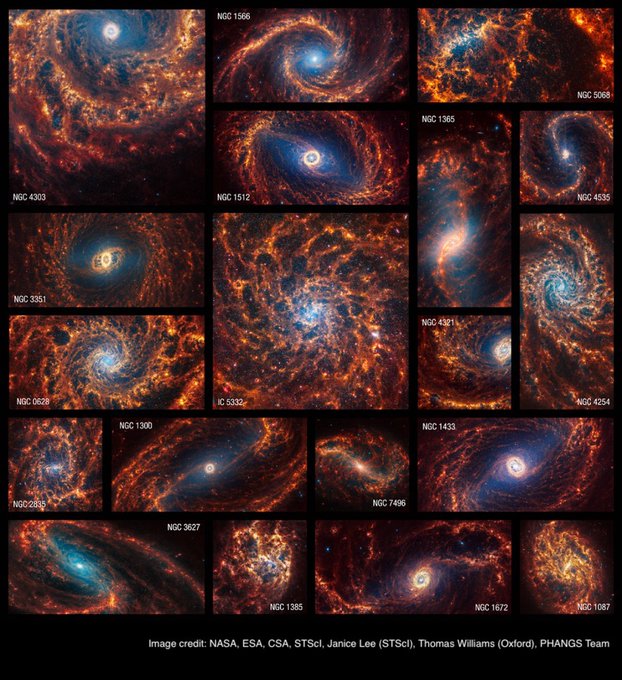Exploring Nearby Spiral Galaxies: James Webb Telescope Unveils Stunning Images

NASA’s James Webb Space Telescope has recently captured stunning images of 19 nearby spiral galaxies, providing scientists with valuable insights into the intricate structures and processes within these celestial bodies. The telescope, also known as Webb, utilized near- and mid-infrared light to observe these galaxies as part of the Physics at High Angular resolution in Nearby Galaxies (PHANGS) program, which involves the collaboration of over 150 astronomers globally.
These images are a significant addition to the existing collection of data on these spiral galaxies, as they complement the observations made by other instruments such as the Hubble Space Telescope, the Atacama Large Millimeter/submillimeter Array, and the Very Large Telescope’s Multi-Unit Spectroscopic Explorer. While the previous images were captured in ultraviolet, visible, or radio light, Webb’s images provide a unique perspective by focusing on near- and mid-infrared light.
One of the highlighted galaxies in Webb’s images is NGC 628, which is located approximately 32 million light years away in the constellation Pisces. The image of NGC 628 reveals the presence of glowing dust, which emits infrared light after absorbing ultraviolet and visible light. Unlike the Hubble Space Telescope, which is only capable of detecting ultraviolet and visible light, Webb’s infrared capabilities capture the otherwise unseen aspects of the galaxy.
In the Hubble image of NGC 628, a densely populated spiral galaxy filled with stars is visible. The view encompasses a light yellow haze that occupies a significant portion of the image, accompanied by a bright core that obscures the light from surrounding objects. The spiral arms, which emanate from the center and rotate counterclockwise, exhibit varying amounts of brown dust. In the outer regions, brown dust lanes alternate with diffuse lines of bright blue stars. Additionally, clusters of star-forming regions are scattered throughout the spiral arms, appearing as bright pink patches.
NEW: A set of highly detailed images of 19 nearby spiral galaxies from @NASA’s James Webb Space Telescope have been released.
— University of Oxford (@UniofOxford) January 30, 2024
The suite of extraordinary images will provide several new puzzle pieces for astronomers and astrophysicists worldwide. pic.twitter.com/WcyHfqOdaW
The Webb image of NGC 628 offers a face-on perspective of the spiral galaxy, revealing a dense population of stars anchored by its central region. Instead of a yellow haze, a light blue haze dominates nearly a quarter of the view. The circular core features a prominent bright blue area, in contrast to the yellow core seen in the Hubble image. The core primarily consists of older stars, which are represented by pinpoints of blue light.
The spiny spiral arms, composed of stars, gas, and dust, are also visible in Webb’s image. These arms originate from the wider area of the blue haze and extend towards the edges, rotating counterclockwise. The spiral arms exhibit varying shades of dark orange or bright orange. Throughout the image, numerous bright blue pinpoints of light represent individual stars. The darker areas within the image are characterized by a reduced presence of orange. Noteworthy features include a dark bubble situated in the top left of the blue core and a wider, elliptical bubble in the bottom right.
The latest images captured by NASA’s James Webb Space Telescope provide astronomers with an enhanced understanding of the intricate structures and dynamics within nearby spiral galaxies. Webb’s ability to detect near- and mid-infrared light has revealed previously unseen aspects of NGC 628, offering valuable insights into the distribution of dust, star formation, and the composition of various regions within the galaxy. These images represent an incredible achievement in our ongoing efforts to unravel the mysteries of the universe.






Leave a Reply